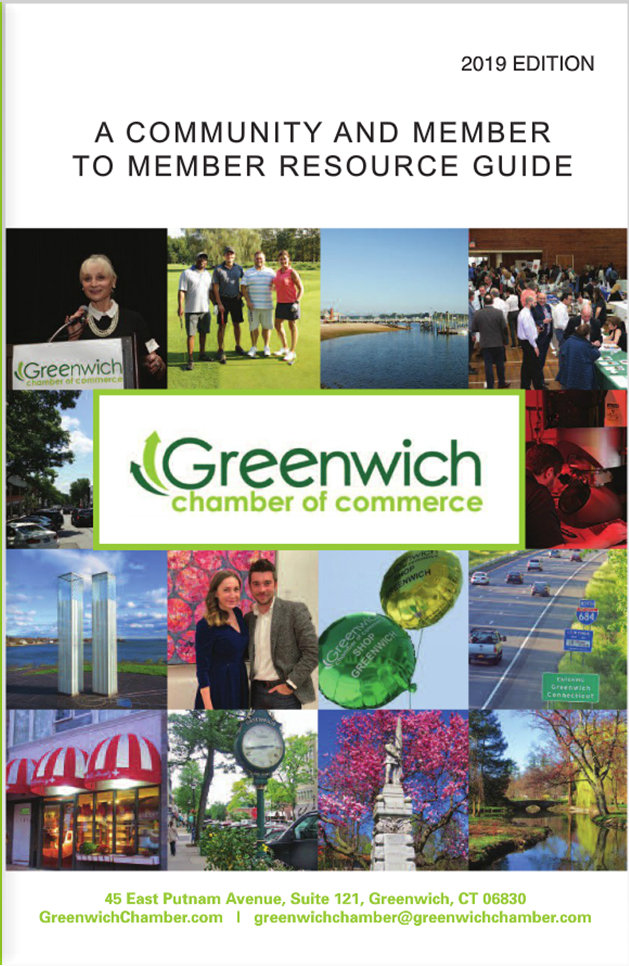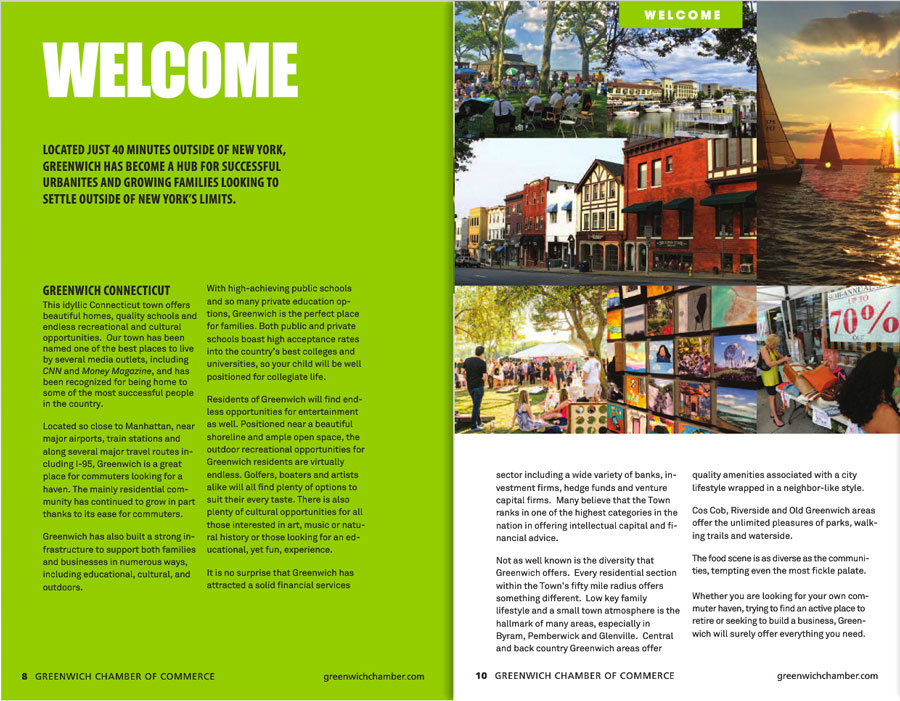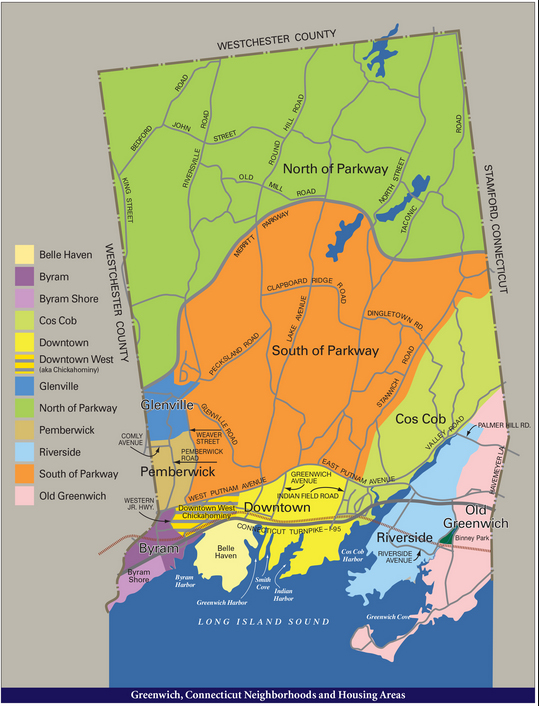Greenwich at a Glance
- Settled in 1640 by Daniel Patrick, Robert Feake, and Feake's wife Elizabeth Fones Winthrop Feake
- Named after Greenwich, England, a borough of London famous for being the home of the Greenwich Observatory - through which the Greenwich Meridian runs.
- Population of 62,256 (2012), with an average density of 930/mi2 (360/km2)
- Area of 930/mi2 of which approximately 25% is water.
- Encompasses several hamlets including Greenwich (or Central Greenwich), Cos Cob, Riverside, Old Greenwich, Mianus, Banksville, Byram, Glenville and others.
Greenwich Town Profile
The 2019 CERC Town Profile of Greenwich is a summary of demographic and economic information for the Town of Greenwich that contains information about population, major employers, education, fiscal issues, labor force and housing.
Greenwich Resource Guide and Member Directory
Our Member Directory (printed and eBook) is a community and member to member resource guide distributed to our community as a welcome and introduction to the town of Greenwich and our business community. The book takes you on a trip through our various parts of town and includes important telephone numbers for Town Hall and various town departments including Police, Fire and EMT. Please use it as your reference for town information.
Current Member Directory
Town of Greenwich Neighborhoods Map
Belle Haven, Byram, Byram Shore, Cos Cob, Downtown, Downtown West (aka Chickahominy), Glenville, North of Parkway, Pemberwick, Riverside, South of Parkway and Old Greenwich.
A Brief History of Greenwich
Reprinted with permission from the Greenwich Board of Realtors’ Welcome to Greenwich guide and Greenwich Magazine.
Known as the Gateway to New England, Greenwich is strategically located. Within an hour's commute to Manhattan, it is bordered by the burgeoning Stamford office metropolis on the east, New York's Westchester County on the west and the waters of Long Island Sound on the south.
A Dutchman named Adriaen Block, sailing up the Sound in 1614 in search of the Northwest Passage, first took note of what is now Greenwich Point, the popular town-owned park and beach in Old Greenwich. Previously known as Tod's Point after its owner, it was acquired by the town in 1945 following a protracted debate in the RIM, which approved the purchase by a single vote. But back in 1640, when the town of Greenwich was founded, the Point was known as Elizabeth's Neck in honor of the wife of Robert Feake. With Captain Daniel Patrick and a few other settlers, Feake bought the land and surrounding areas from the Siwanoy Indians for the princely sum of 'Twentie Five Coates.' (However, the deed shows that only fourteen English coats were actually delivered.)
Captain Patrick, a feisty fellow, had been thrown out of the Massachusetts Bay Colony for unbecoming behavior and found a less God-fearing atmosphere in this Connecticut frontier settlement. He did nothing to further good relations with the Indians when he killed Chief Mianos in an altercation. He got his comeuppance, however, when he was shot in a brawl with an enraged Dutch soldier. Feake became deranged and wandered off into oblivion. But another founder, Jeffrey Ferris, who named the town Greenwich after his birthplace in England, still has progeny here today.
Greenwich was torn apart by the Revolutionary War. At the start, many residents were loyalists, but sentiments changed radically when General Tryon raided the town and burned much of it to the ground. The portly General Israel Putnam, Washington's second in command, barely escaped the redcoats by dashing out of Knapp's Tavern and somehow riding down a nearby cliff, known forever after as Put's Hill. Knapp's Tavern, licensed as a 'publick house of entertainment and strong drink' in 1734, is now Putnam Cottage, headquarters of the Greenwich branch of the DAR and maintained as a Revolutionary War museum.
Throughout the nineteenth century, Greenwich farms supplied produce for the New York market. Its waters were the most bountiful source of oysters anywhere this side of the Chesapeake. Granite from our quarries was barged to New York for its office buildings and bridge abutments, including the Brooklyn Bridge completed in 1883. Fruits and vegetables were shipped from Cos Cob docks in front of the Bush Holley House, now the centerpiece of our flourishing Historical Society compound.
The year 1848 marked a major turning point in the history of Greenwich when the New York, New Haven and Hartford Railroad inaugurated service to Greenwich and beyond. The trip between New York and Greenwich, which used to take a full day by horse, stage coach or packet boat, now took only an hour, and brought the first wave of wealthy New Yorkers to Greenwich. They built magnificent summer homes on the shore in Belle Haven and in backcountry Greenwich, ushering in the era of the great estates. Among the arrivals was the infamous Boss Tweed who set up a casino on Great Captain's Island and a many-roomed mansion adjacent to the present-day Indian Harbor Yacht Club.
Through the twentieth century and up to now, the town underwent a metamorphosis from a rural farming and fishing economy to a sophisticated suburban community. With the ever-growing number of businessmen and their families eager for life in the country, Greenwich became a bedroom for New York commuters; and many of the larger estates were subdivided into four-acre lots to accommodate today's mega-mansions. At one point it was proposed that the United Nations headquarters be located in Greenwich, occupying much of our backcountry. But the plan was narrowly defeated in the face of local opposition. Instead, the area has been developed as the premier Conyers Farm residential community with ten-acre lots and polo grounds.
Almost on a par with the arrival of the railroad in the last century was the building of I-95 in the 1950s. Cutting a swath through central Greenwich, it was responsible for accelerating the pace of change since WWII. Office buildings sprang up and Greenwich became the headquarters for major corporations. More recently, these corporations have been replaced by the ubiquitous hedge funds that have earned Greenwich the sobriquet of Wall Street East. And today, more people are commuting into Greenwich than out.
Ultimately, it is the people who live here that make Greenwich so interesting and desirable. While widely known for its many wealthy residents such as business executives, international entrepreneurs and, lately, hedge fund managers, Greenwich is actually a diverse community that includes a solid base of middle-class and blue-collar residents. Some of the oldest and most respected Greenwich families have descended from the Italian immigrant workers who built the railroad. The town is also geographically diverse, composed of a number of small villages, each with its own distinctive characteristics.
Villages of Greenwich
Mention the town of Greenwich, Connecticut, to anyone and chances are they have heard of it. Greenwich is home to artists, actors, sports personalities and, yes, corporate executives and leaders in the world of finance. Yet, it is both a wealthy and diverse community. Its fifty square miles, stretching from the backcountry to Long Island Sound, encompasses seven villages or hamlets, each with its own distinct identity and geography, many with roots that predate the Revolutionary War.
Chronologically, this is how our town has evolved:
OLD GREENWICH
Old Greenwich is where it all began. On July 18, 1640, the Siwanoy Indians, for the price of twenty-five English coats, sold the land that is now Old Greenwich to four Englishmen. One of the Englishmen, Jeffrey Ferris, named the area after his birthplace, Greenwich, England. As Greenwich developed to the west, Old Greenwich became known as 'Old Town.' In 1872 the name was changed to Sound Beach at the urging of the New Haven Railroad, which preferred that name for its rail stop. So Sound Beach it stayed until 1930 when the area was renamed Old Greenwich.
Old Greenwich has evolved from a farming community to a summer resort to the quiet commuter community it is today. Residents of the village take a particular pride in their community with its special amenities: its intimate downtown shopping center; proximity to popular Greenwich Point with its fine beach, park and public boating facilities; and scenic Binney Park, where Little League baseball and soccer are regular weekend events and the annual model sailboat races on the pond draw many young would -be sailors.
COS COB
As the Old Town farmers struggled with the area's rocky soil, the tiny hamlet to the west prospered as a seaport. Cos Cob, originally known as Mianus, was named after the Siwanoy chief Mianos. It was an Englishman named John Coe, an early settler, who built a seawall at the mouth of the Mianus River and referred to it as a cob. He left in 1659, but the name Cos Cob (without the' e') remained.
Cos Cob flourished as a seaport during the 1700s and 1800s. At the turn of the nineteenth century, it evolved into an intellectual and artist colony, playing host to the likes of Eugene O'Neill, Willa Cather and Anya Seton, whose father, Ernest Thompson Seton, was a founder of the Boy Scouts of America. The historic Bush-Holley House, presently the home of the Historical Society of the Town of Greenwich, became famous as the residence and studio of the renowned Cos Cob School of American Impressionists, which included Elmer MacRae, Childe Hassam and John Twachtman.
Today, Cos Cob has its own shopping center. The lovely Mianus River flows through its residential areas and there are extensive marinas on the upper Mianus Harbor.
CENTRAL GREENWICH
In 1686 the tract of land between the Byram and Mianus rivers was traded by the Miossehasseky Indians for just thirty acres of planting ground elsewhere. Known then as Horseneck, it was the principal farming area of the town and supplied much of the produce for New York. The advent of the railroad in the mid-nineteenth century was an economic boon for central Greenwich, transforming Greenwich Avenue into the major shopping center it is today, with its many upscale stores and top-rated restaurants. Trademarks of the Avenue are the uniformed policemen who direct traffic every weekday. Central Greenwich is the hub of economic activity and the seat of town government. It is also where the main Greenwich library, Bruce Museum, Greenwich Hospital and many other town institutions are located.
The central Greenwich area offers a wide range of residential opportunities, from apartments and condominiums convenient to shopping and public transportation to midcountry homes and the exclusive waterfront properties in Belle Haven and Mead Point.
GLENVILLE
This tiny mill town in western Greenwich was founded in 1774 by Baptist settlers, who established their church by the Byram River. Its industrial history began with a mill for grinding Peruvian bark into patent medicines. Later, the American Felt Company turned out the majority of felt for hats in the United States. It operated until the mid -1970s. Restaurants, office space and condominiums now occupy the mill, noted for its scenic millpond and waterfall. There is also a small shopping area for everyday needs.
RIVERSIDE
Known as Mianus Neck until 1870, Riverside was predominantly a community of farmers, fishermen and oystermen. Until the middle of the nineteenth century, Riverside Avenue was known as the Potato Road for all the potato cellars near the cove. Today, it is one of the most desirable of our suburban communities. It is closely linked to neighboring Old Greenwich, and its abundant stretch of waterfront on the river, harbor and Long Island Sound attracts those who have a particular interest in living near the water and in sailing and fishing. Like Old Greenwich, its location near a railroad station makes it ideal for commuters to the city.
BYRAM
Tucked into the southwest comer of town, Byram was settled in 1660 by Thomas Lyon and was originally known as New Lebanon.
Today, Byram is a diverse residential community. Beautiful shorefront estates with dramatic views of the Sound are backed by more modest residential properties in the rest of the village. Together with neighboring Port Chester across the Byram River, there are any number of fine restaurants featuring a variety of ethnic cuisines plus retail shops of every kind. An ongoing program revitalizing properties along the shores of the Byram River and Byram's central business district is giving this Greenwich enclave a decidedly up-and-coming future.
BANKSVILLE
Banksville was named after Samuel Banks, who settled on the upper reaches of the Mianus River in the northeast corner of Greenwich in 1700. For the next 200 years, it was a quiet farming community, but in 1904 Edmund Converse acquired more than 1,000 acres to create Greenwich's greatest estate, with forty buildings and a staff of 200. Farming operations continued up until 1960, after which time it lay fallow for twenty years until it was sold to the Conyers Farm Partnership and its then 1,468 acres were subdivided into sixty lots. Conyers Farm is the home of many well-known residents who can afford its magnificent ten-acre lots. It is also the locale for the Greenwich Polo Club, where many town residents go in the summer to enjoy the polo games on a Sunday afternoon. (An interesting sidelight: Conyers Farm would not exist nor would most of backcountry Greenwich be the same if a proposal in 1945 to locate the headquarters of the United Nations here had not been defeated by an alarmed group of Greenwich citizens.)
Banksville's small business center near the New York State line is reminiscent of a simpler time. Many of its residents refer to Banksville as the land that time has forgotten.
THE BACKCOUNTRY AND MIDCOUNTRY
Any description of the unique areas of Greenwich wouldn't be complete without mention of the extraordinarily beautiful midcountry and backcountry that encompass nearly two-thirds of the town's geography. Four-acre zoning is the rule in most of the backcountry area, defined as north of the Merritt Parkway, while one- and two-acre zoning is most common in the midcountry to the south.
Thanks to preservation efforts by the Greenwich Land Trust and the generosity of a number of Greenwich property owners, there is still a remarkable amount of open space remaining, especially in the backcountry. The area is characterized by a diversity of rivers, lakes and ponds, winding country roads, woods and meadows, and scenic glacial carved gorges - enough to please the eye of the most ardent environmentalist.
Here is where most of the town's golf courses and many of its parklands are found, including the Audubon property with its impressive headquarters and the Kimberlin Nature Education Center. Perhaps most surprising, this is all within thirty-five miles of Manhattan.




